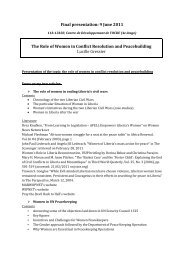Women's Economic Opportunity Index - Economist Intelligence Unit
Women's Economic Opportunity Index - Economist Intelligence Unit
Women's Economic Opportunity Index - Economist Intelligence Unit
- No tags were found...
You also want an ePaper? Increase the reach of your titles
YUMPU automatically turns print PDFs into web optimized ePapers that Google loves.
Appendix IISources and definitionsWomen’s economic opportunityA new global index and rankingAppendix IISources and definitions of the Women’s <strong>Economic</strong> <strong>Opportunity</strong> <strong>Index</strong>Where the quantitative or survey data have missing values, the <strong>Economist</strong> <strong>Intelligence</strong> <strong>Unit</strong> has estimated the scores1) Labour policy and practiceThis category comprises two subcategories: Labour policy and Labour practice1a) Labour PolicyIndicator Source Year Indicator definitions and constructionEqual pay for equal work:ILO Equal RemunerationConvention (No 100);country progress inaligning national policywith the terms of theConventionCreation of a codingand scoring schemeby the <strong>Economist</strong><strong>Intelligence</strong> <strong>Unit</strong> basedon International LabourOrganisation documents2003-09 Equal pay, codified in law, is a principal step in providing a level playing field for women. Thisindicator is a composite score that considers whether a country has ratified and domesticatedthe Convention, and whether it has met the Convention’s stipulations, as noted by the ILO.This indicator therefore assesses a country’s compliance with all terms of the Convention. The<strong>Economist</strong> <strong>Intelligence</strong> <strong>Unit</strong> has created a coding scheme based on the ILO’s annual assessments(noted in the Comments of the Committee of Experts on the Application of Conventions andRecommendations) of a country’s progress in meeting the Convention’s terms.Indicator creation: A country receives 1 point for each step it has taken to align national policywith the Convention, as follows:1) Ratification of the Convention2) Establishment of government policy and an organisation/committee to promote conventionprinciples3) Principle of equality of remuneration domesticated in labour law4) Principle of equal value domesticated in labour law5) Job appraisal/evaluation mechanisms6) Co-operation with workers and employers’ organisations to involve them in achieving wageequality7) Direct/indirect acknowledgement of inequality through government statements/studies/information supplied to the ILO8) Law inspection/enforcement mechanismsThe scores are added to determine the number of steps governments have taken to ensureequality of pay (a higher score implies better progress in meeting the terms of the Convention).Countries that have not ratified the Convention have been assessed by the <strong>Economist</strong> <strong>Intelligence</strong><strong>Unit</strong> on the same criteria listed above.The maximum score a country can receive is 8, where 8= most favourable.127 <strong>Economist</strong> <strong>Intelligence</strong> <strong>Unit</strong> 2010




